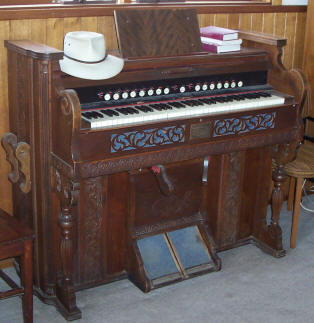The harmonium may seem an unexpected instrument to find
on a listener's guide to classical music. After all, in the last half of
the 19th century and the first half of the 20th
century it was mainly associated with parlour music or with the sort of
smaller chapel that couldn't afford 'the real thing' - a pipe organ.
However, there were a few composers of this period who
were prepared to give he harmonium a prominent role in some of their
works - particularly as a 'binding' texture for small ensembles. Perhaps
the most prominent examples are Dvořák’s Bagatelles for strings and harmonium, and
Rossini's
Little Solemn Mass for 2 pianos, harmonium, soloists and choir. Both
Liszt and
César Franck also wrote for
the harmonium.
However, the composer who possibly treated the harmonium with the most
respect was Percy Grainger,
and he uses the instrument with delicacy and intelligence in many of his
smaller ensemble works.
The sound from a harmonium is produced, as with the
accordion family, by a stream of air being blown (or sucked in the case
of an American Organ) through a reed. While reed stops on a pipe organ
usually have a resonating pipe, in the case of the harmonium there is
usually no additional resonator. A piano-like keyboard controls the
notes to be played and the stream of air is usually provided by the
player pumping a pair of foot bellows. Like a pipe organ, there will
usually be a number of different banks of reeds with different timbres
which are controlled by ‘stops’. Like a pipe organ, a harmonium may have
more than one keyboard, but the foot bellows usually preclude a pipe
organ style pedalboard. Also, like many pipe organs, many harmoniums
will have their reeds in a semi-enclosed box with an opening shutter
system to allow some volume control. In the case of the harmonium these
shutters are usually controlled by outwards movement of the players
knees pressing against a pair of levers.
Small portable harmoniums became popular with mission
groups such as the Salvation Army for street corner performances. Even
smaller ones where the player pumps a bellows with one hand and plays
the keyboard with the other hand often play a role in Indian classical
music.

A typical single manual harmonium
The nature of the reeds means that, even though there
may be large number of stops available, there is not a great range of
timbres. Nor are the reeds suitable for fast delicate articulation in
the style of a chamber pipe organ. The harmonium is probably at its best
providing a sustained harmonic foundation for instrumentalists,
vocalists and choirs.
In Renaissance Europe, a reed organ called the regal
with a quite aggressive tone (similar to a consort of crumhorns) was
commonly used. Its almost snarling tone made it ideal for accompanying
villains and other-worldly characters in the early operas of
Monteverdi
and his contemporaries. The harmonium was a development of this
instrument with a more 'refined' tone suited to nineteenth century
sensibilities.
Although the harmonium may not have the snob value of
some 'higher class' instruments, it remains one of the simple glories of
western music to sit in a drawing room and listen to a
Stephen Foster
song performed by a good lyric tenor with a fine harmonium.
More on the difference between the Harmonium and the American Organ
In a recent newsletter we asked if any of
our readers could tell us the difference between a harmonium and an
American organ (or is that AN harmonium and A American organ?). Michael
replied:
“One cannot help rising to the challenge (bait?) offered by the
latest White Hat newsletter.
Both the harmonium and American Organ are ‘reed organs’ but are not
one and the same thing. The main difference is technical, with a
harmonium differing from an ‘American organ’ in blowing air through its
reeds, whereas the American organ sucks the air. There is also a
noticeable difference in sound (not unlike that of blowing and sucking
air through a harmonica) in that the harmonium has a more vibrant,
brilliant sound, and the American-organ a sweeter and more mellow one.
There are other differences, some rather more subtle. The harmonium
is more likely to be French or British in origin, and usually
flat-topped in design, rather desk-like if that's the right term, with
the veneers more commonly in oak, but also in burr-walnut or rosewood.
American organs were typically American or Canadian in origin and were
considered by their makers as being slightly more advanced technically
in that the 'reeds' were easily accessible for cleaning and tuning. It
will come as no surprise, especially to owners of Jaguars and Citroens,
to learn that the French and British harmoniums were somewhat more
difficult to service. Just to muddy the waters, it is possible that a
harmonium might indeed be American ... but these instruments are
considered (historically) as ‘transitional by the Americans and a
prelude to the latter ‘American-organ’.”
|
|
Copyright © 1995 - 2026
White Hat.
|
Selected harmonium sheet music:

look inside
|
Petite Messe Solennelle
Composed by Gioachino Antonio Rossini. Edited by Nancy Fleming. Choral Works (inc. Oratorios). Classic Choral Works. Standard Choral Works. Performing score. 176 pages. Duration 77'. Oxford University Press #9780193380455. Published by Oxford University Press (OU.9780193380455).
|